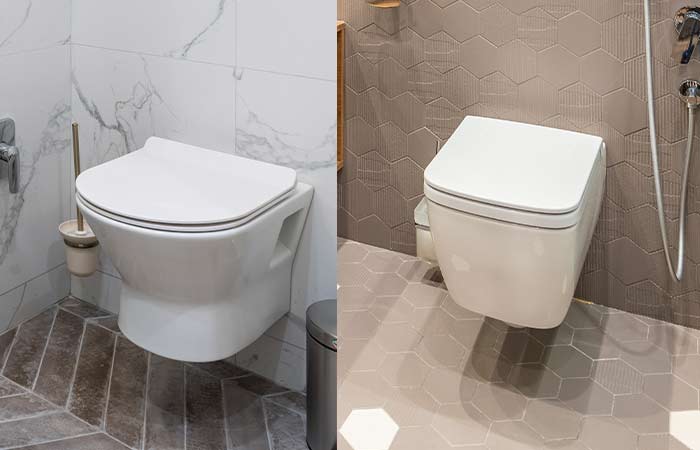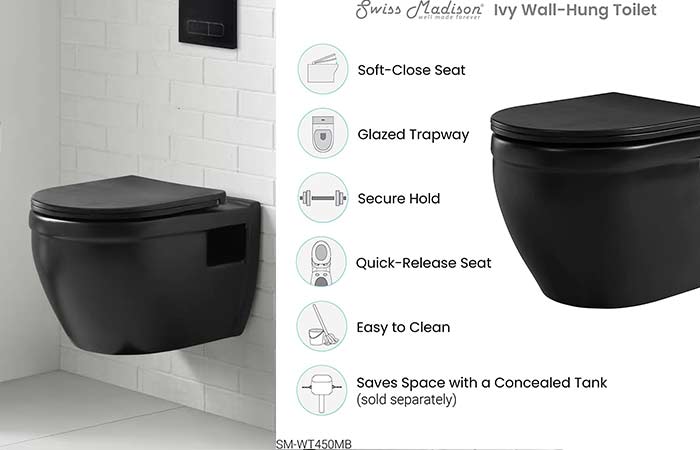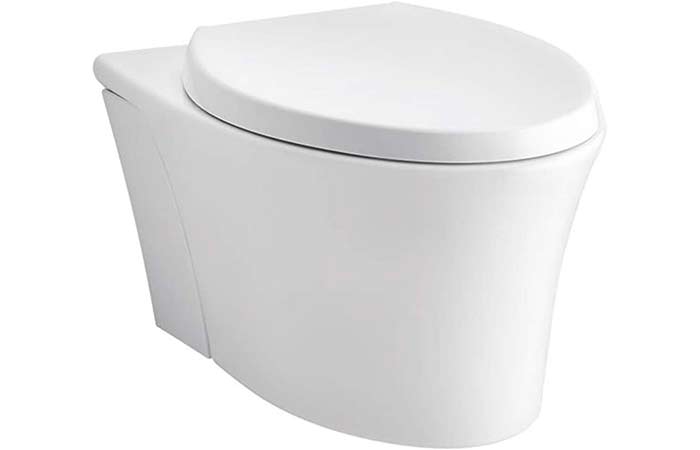Common Problems with Wall Mounted Toilets + Fixes
While a wall-mounted toilet is a good modern option that is more aesthetically pleasing and with various benefits, it, like normal toilets, comes with a list of potential concerns that you should be aware of before selecting to install them in your home.
Some of the most common problems with wall-mounted toilets include water running after a flush, issues with the tank’s water level, leaks from poor connections, and movement caused by an unlevel installation.
Most of these issues are simple to explore, and you may not even need to call a plumber. You must first identify the problem and then proceed with troubleshooting. The following are details of the aforementioned problems and potential solutions.
Toilet Loosening from the Wall
Quite possibly, the most common issue with wall-mounted, also known as floating or wall-hung toilets, is when the screws on the carrier become loose causing the bowl to shake or rock.
This might happen due to poor installation in the first place. But once you detect this problem, you have to fix it sooner rather than later. Or it might lead to other many issues.
You will notice this problem when sitting down the bowl as it slightly wobbles. Incorrect installation is the most probable cause of this issue and is best addressed as early as possible as it can lead to more significant problems in the future.
Fixing a slacking wall-mounted toilet
You may easily repair a loose toilet bowl by removing the carrier from the wall and reinstalling it.
This can be done by you, if you were the original installer of the toilet, or if you have installation experience. You are in a good position to do it yourself if you have DIY abilities.
However, seek assistance so that you have a helping hand to ensure that the toilet is properly fastened to the wall and to avoid inadvertent damage to the toilet and the wall.
If your DIY skills are not good enough, it is an excellent decision to call an expert plumber to perform the installation job for you.
Because the primary source of this issue is installation, it is strongly recommended that you contact specialists to handle the installation of your wall-mounted toilet.
Reinstallation is best performed by a qualified and certified professional as it will give you the assurance that the wall mounted toilet is properly installed and fitted with the wall
This is a relatively easy, although slightly more expensive, approach. You can, however, rest assured that the toilet bowl, carrier, and tank fulfill installation standards.
Water Running after Flushing
Wall-hung toilets, like floor-mounted toilets, might have issues with running continuously or not properly shutting off after flushing. This issue often happens in a wall-hung toilet with a tank when the ball cock or float inside the tank is either not adjusted properly or out of service (old or damaged)
Water may also continue to flow even after a flush if the flapper in the tank doesn’t end up sitting flush to the opening.
The result is a gradual leak into the toilet bowl. As the water level falls below the fill level, you can hear the water running as the tank refills.
Fix
In the case of a faulty ballcock or float, you’ll have to start by opening the cover to access the tank’s components. Take a screwdriver and adjust the ballcock and float. Then twist them to loosen them up. And adjust the height until you see that the constant water flowing stops. Then twist it again to tighten it.
If the adjustment doesn’t fix your problem, you have to remove and replace the entire assembly.
To repair a leaky flapper, remove the flush actuator cover and inspect the flush valve. You’ll see a bar connected to a rod or spindle that connects to the tank’s real flush mechanism. To improve the seal, try adjusting the bar or rod by hand.
If this doesn’t work, it’s possible that the rubber valve seal, which is part of the flush mechanism, has worn out and has to be replaced. You may be able to access it yourself depending on your layout; if not, you will need to open up the drywall to access the tank.
In a wall-mounted toilet with a flushometer design, the flushometer can be changed to fix the flowing water issue. Replacing the flushometer should resolve the issue because this device controls water in the same way that the ball cock and float do.
Water Leaking into the Wall
Another common issue with wall-mounted toilets is water leaking into the wall. If you notice that water leaks into the wall every time you flush the toilet, fix it right away. If you don’t take care of this one, it will cause more issues down the road.
Water leaks within the wall mostly occur when the plumbing is not correctly connected to the toilet.
Water leaks cause damage to the bathroom walls in this situation. As a result, if this problem is not resolved quickly, your entire expenditure in the form of bathroom repairs will rise.
Leaking Wall-mounted Toilet Fixes
Water pouring into the toilet wall could be caused by a number of different problems, so you should properly inspect each component to identify the source of the leak before cutting off the toilet’s water supply. The solution will depend on the source of the leak; applying a color dye to pinpoint leaks more precisely is something you should also think about.
Here are solutions to some of the potential causes of leaks:
Sometimes, if the toilet bowl is not properly fitted and mounted on the carrier on the wall, it leads to water leakages. To fix this issue, you should tighten the bolts that are securing the toilet bowl to the carrier. Securing this should turn off the water leak.
A faulty or worn-out wax seal could also be the source of the leak. To resolve this issue, first, remove the bolts that secure the toilet bowl to the wall and disconnect it. To avoid damaging the bowl, you may need to have someone assist you in holding the bowl as you remove it.
Open the drain with a putty knife and scrape out the old wax ring. Install a new wax ring before reinstalling the bowl on the wall. Again, you might need assistance in supporting the bowl while you tighten the mounting nuts to secure it in place.
If the preceding approach does not work, use color drops in the toilet to look for cracks. Simply add a few drops of dye into the tank, and the color will settle on the cracks. When you discover a leak, you must replace the damaged component or, in severe cases, the entire assembly.
Leaks into the toilet wall could also be as a result of a loose connection in the water supply line. To fix the issue you should first examine to see the exact place where the leakage is happening. In case it is a problem with loosened nuts, tighten the line with a wrench and it’ll stop the leak. You might also need to replace the entire supply line if the damage causing the leak is extensive.
Malfunctioning water regulator
In other cases, the issue could be caused by a malfunctioning water regulator. In such a case, you should think about hiring a professional plumber to deal with it.

More Wall-hung Toilet Cons/Disadvantages
Besides the common problems with wall-hung toilets, the following are more downsides.
They are costly to acquire.
While there are very expensive non-wall-mounted toilets, by and large, wall-hung toilets cost more than regular toilets.
Difficult and Pricey to Install
The biggest deterrent is that they are more challenging to install than standard floor-mounted toilets. When your plumbing must be shunted, the process can be challenging and time-consuming.
Finally, the cost of installation is the largest disadvantage of wall-hung toilets. The components themselves are rather inexpensive, but installing them correctly will be a significant undertaking and undoubtedly expensive.
Weight limit
The minimum weight limit of wall-mounted toilets is 500 pounds as required by the United States’ National Consensus Standards. Toto Aquia wall-hung toilet has among the highest minimum weight limit of 800 pounds.
Harder to fix if they break
Additionally, because of how difficult it may be for plumbers to access cisterns for repairs due to their concealed designs, they aren’t as practical as other options in the event that yours breaks.
Is a Wall-mounted Toilet Good? What are the Pros?
Wall-hung toilets are not entirely bad choices; they come with benefits that regular toilets may lack. The following are some of the advantages of a wall-mounted toilet.
Further Reading: Wall-mounted vs Standard Floor-mounted Toilets
The first pro of wall-mounted toilets is how they save space. They do not take up much area because they do not have a large cistern. They may be put alongside other bathroom fixtures without making the space feel too crowded.
Wall-mounted toilets also create the appearance of space since they use empty space on the wall rather than the floor.
However, you will need to find a decent location to install it in because there must be enough space to conceal the hidden cistern and frame. With the utilization of stud walls and compact designs, they are still your best bet for tiny areas.
wall-hung toilets have a very streamlined, modern look. The main reason is that the tank of a wall-mounted toilet is hidden in the wall. This gives you the ability to eliminate the space required for the tank and even the several inches of space behind the toilet, resulting in up to 10 to 12 inches of additional floor space in the bathroom. They are therefore more space-economic than their floor-mounted counterparts.
Cleaning is made substantially easier because the toilet bowl of a wall-mounted toilet is not attached to the floor. There won’t be any difficulties in cleaning the floor, and all traces of dust and grime will be removed. It doesn’t have any hard-to-reach crevices where dust and debris can gather, to be more precise.
Additionally, you won’t have to stoop to clean the bathroom’s often difficult-to-reach regions, such as the area around the toilet bowl and you can instead simply use a mop. Furthermore, there is no sealant holding the toilet to the ground which might discolor over time. A wall-hung toilet may withstand the test of time with little work.
Versatility in Height Adjustment
A wall-mounted toilet can provide more adaptability because it can be set at any desired height unlike in a floor-mounted toilet where not much can be done to adjust the height. They are available in two different heights: standard height and comfort height (which is a few inches higher).
In contrast to standard toilet bowls, which have a fixed height, a wall-mounted model can simply adjust to your height to provide the best level of comfort.
Of course, if you have limited movement, adjusting the height of the bowl is a huge help. You will be able to avoid the risk of falling and boost your comfort this way. Finally, installing a hanging toilet is a breeze.
Many people consider wall-hung toilets to be fashionable and futuristic. We can understand why people consider them to be a fantastic complement to modern bathroom decor. When combined with a gorgeous bathroom design, wall-mounted toilets offer a distinctive appearance that never fails to impress.
Additionally, the practical portion of this toilet is recessed and not apparent, which contributes to its aesthetic appeal. The flush button and toilet bowl are the only two things that are visible, giving your bathroom a highly contemporary appearance..
The appearance of the floor has improved, too! Additionally, you’ll be able to conceal all of the unsightly pipework in the wall behind your toilet to give your bathroom a tidy and open appearance. Why not use the extra, clear wall space to establish a gorgeous, eye-catching wall?
The hidden cistern rarely needs maintenance, and if placed correctly, they don’t need any touch-ups. The cistern can, however, be accessible through the flush plate if maintenance is required. Therefore, don’t fear that you’ll need to tear down the entire wall to address a problem.
Last but not least, the wall-hung toilet is particularly well-liked for its environmentally friendly feature due to its water savings. You may select how much water to use with many hidden cisterns because they have adjustable flush volumes.
Less Noise
Additionally, it is also quieter than most regular floor-mounted toilet installations.
Some wall-hung toilets are cheaper than high-end floor-mounted toilets.
What are some of the Best Wall-hung Toilets?
Some of the best include;
Ivy Wall Hung Elongated Toilet

Swiss Madison Well Made Forever SM-WT450MB, Ivy Wall Hung Elongated Toilet is one of the most affordable products out there. It features
- Dual flush with high-performance gravity 0.8 / 1.28 gallon per flush (gpf)
- Compatible with all Carrier brands
- Porcelain One-piece seamless and easy-to-clean design
- Slymm soft close quick-release seat included
- All bolts & screws needed for installation are included.
KOHLER K-6299-0 Veil Wall-Hung Toilet

Another good option from Kohler is the Veil wall-hung one-piece compact elongated toilet. The Mounting hardware is completely concealed, giving Veil a sleek, seamless look that is easy to clean.
- This piece includes wall-hung bowl with a Grip Tight Reveal Q3 seat
- Combines with the K-6284 In-Wall Tank and Carrier System to create a complete K-6303 Veil toilet